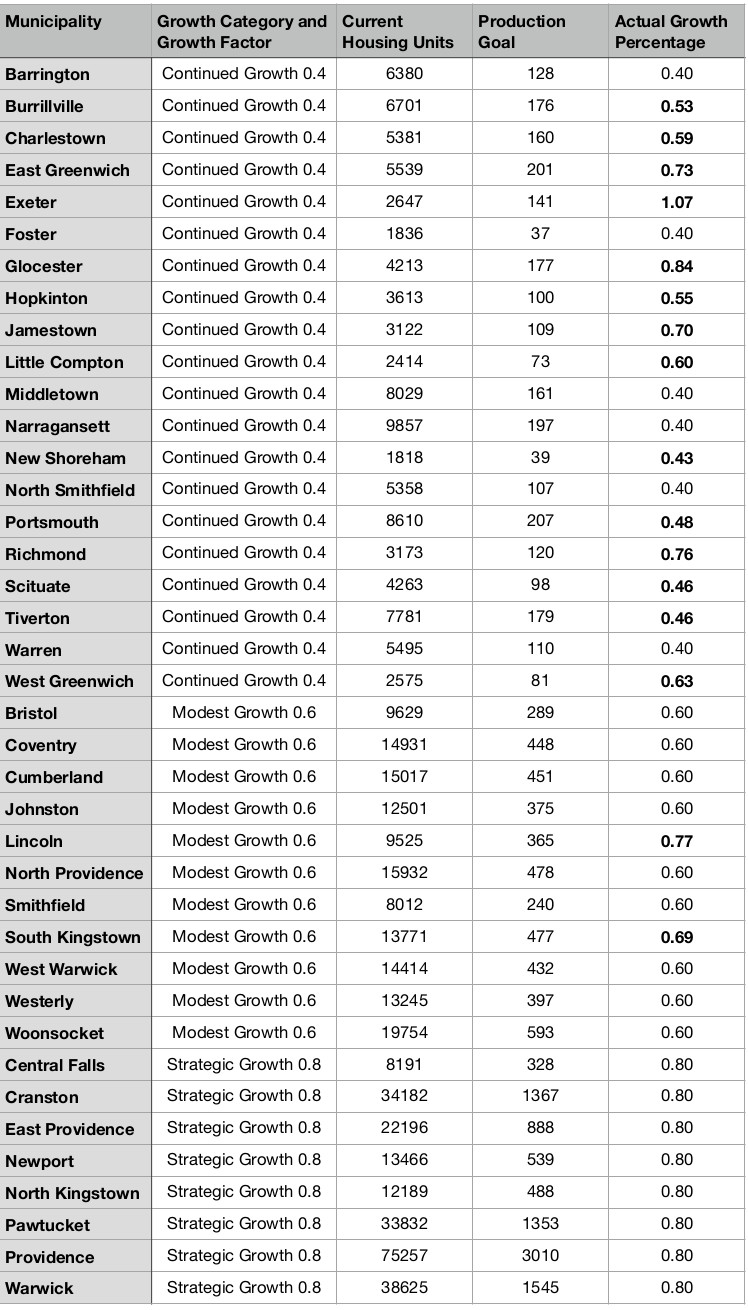New State Plan, Housing 2030, Mandates Rural Towns Grow At A Faster Rate Than Urban Areas
“Housing 2030”, the RI Department of Housing’s newly released plan to increase home construction in our state, claims that its housing goals for each community are based on the availability of services such as public sewer and water, transit, and the location of jobs. The plan’s text leads the reader to believe that the urban areas will be the fastest growing and that our state’s rural towns will have the lowest growth mandates. The plan (in a table found on page 33) then assigns a housing production goal for each community that reverses this scheme and assigns rural towns the highest growth rates in the state. Under this plan, the rural communities of Exeter and Glocester are assigned higher growth rates than Providence and all other urban areas. Richmond and West Greenwich are required to grow faster than West Warwick or Westerly. And Charlestown is required to grow as fast as North Providence. 14 of the 20 communities described as places where housing development should not be concentrated have assigned numerical growth rates higher than those advised in the text.
The text states that rural towns are expected to permit, on average, housing units equal to at least 0.4 percent of their existing housing stock annually. Towns with above-average job concentration are assigned a growth factor of 0.6, and the urban areas with “above-average job concentration and robust public transit infrastructure” are expected to grow at a rate of 0.8. The plan provides a rationale for these growth factors, but without any explanation, it then inserts another number based solely on the housing units permitted in that town between 2019 and 2023. Exeter, with 141 new homes during that period, was the fastest growing community in the state, and now this plan mandates that Exeter will continue in that role with a 1.1 growth factor rather than 0.4.
For the last fifty years, housing production has been concentrated in Rhode Island’s rural towns. Housing units increased in my town of Charlestown by 173% between 1970 and 2020, while the state’s population only increased by 15%. Even in my town’s slowest-growing decades, we have grown faster than the state.
Another state plan, Land Use 2025, Rhode Island’s plan for conservation and development in the 21st century, published in 2006, was meant to reverse the continued loss of forest and farmland by retaining the distinction between urban and rural areas. The plan states that areas within the urban services boundary are identified as optimum areas for accommodating the bulk of the state’s development needs. They are areas where growth should generally be encouraged by state policies and investments. Other areas include lands more suited for conservation uses and lands outside the urban services boundary that are not needed to accommodate the state’s growth needs. In these categories, it is recommended that growth and development not be encouraged or supported.
As a still rural town outside the urban services boundary, Charlestown embraced Land Use 2025. Between 2000 and 2022, in collaboration with groups such as The Nature Conservancy and RI’s Department of Environmental Management, we preserved thousands of acres of land; employed conservation development for subdivisions; managed our waste water; and despite the RI Legislature stripping local control of Zoning, the Planning Commission continues to do our best to protect our ground water and wildlife habitats.
The new 2030 housing plan states, “increasing housing density in areas with existing public infrastructure avoids additional infrastructure costs and should be the first places that are encouraged for housing development.” This idea and others in the plan roughly follow Land Use 2025, but the assigned housing production numbers in the plan reverse the goals of Land Use 2025 and enforce the continued population movement toward the more rural areas, with its related loss of forest, farms, wildlife habitat, and natural beauty.
Our state needs more housing, but that should not be done in direct opposition to Land Use 2025, with the highest growth rates mandated for Rhode Island’s last remaining rural areas.
You can download and read the new State Housing Plan (Housing 2030) at housing.ri.gov/media/3251/download (40MB)
Comments on the plan should be submitted by May 23 to the Rhode Island Division of Statewide Planning at https://planning.ri.commentinput.com/?id=WpEDKgZNa
You can also read Land Use 2025, the State’s plan for conservation and development in the 21st century at https://planning.ri.gov/sites/g/files/xkgbur826/files/documents/121/landuse2025.pdf
Below is a table showing Housing 2030’s growth category for each town, the prescribed five year production goal for that town, and what that production goal actually calculates out to. Actual growth percentages are highlighted in bold where they are higher than the goal for that community type. Note that almost all the rural towns have production goals greater than the growth factor, only two of the modest growth towns are greater, and none of the urban communities have production goals higher than their community type growth factor.

You can learn more about the author, Ruth Platner, a member of the Charlestown Planning Commission, on her profile page.
